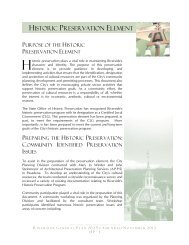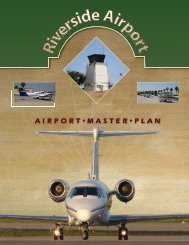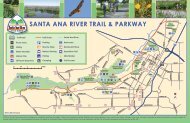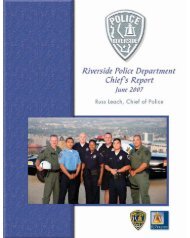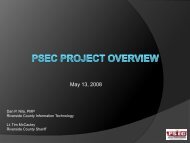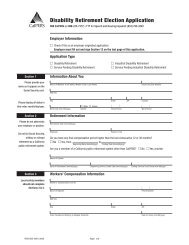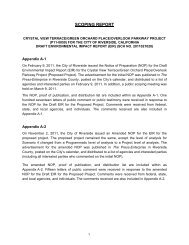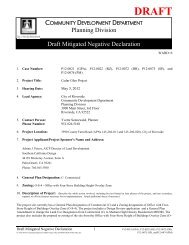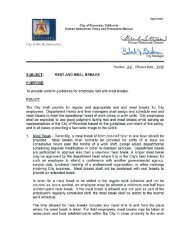Northside - City of Riverside
Northside - City of Riverside
Northside - City of Riverside
You also want an ePaper? Increase the reach of your titles
YUMPU automatically turns print PDFs into web optimized ePapers that Google loves.
the water company is <strong>Northside</strong>r Sam Gregory, who still farms and irrigates his<br />
rural parcel west <strong>of</strong> the survey area. As Alamo Tract lands have changed hands and<br />
been reduced to smaller lot sizes throughout the 20 th century, shareholders have<br />
dwindled, but the company remains the only privately-owned water company in<br />
the <strong>City</strong>. Several original above- and below-ground structures <strong>of</strong> the well-and-canal<br />
irrigation system are still extant outside the survey area, and the Alamo Water<br />
Company lands and any associated buildings, structures, or objects are<br />
recommended for further study in Phase II (Mermilliod & Klure 2005a).<br />
Railroad<br />
Though <strong>of</strong>ten overshadowed by the pivotal role that canal irrigation played in the<br />
early prosperity and enduring stability <strong>of</strong> <strong>Riverside</strong>, the success <strong>of</strong> citriculture, local<br />
tourism, and settlement through the introduction <strong>of</strong> rail transportation into the<br />
region and the <strong>City</strong> cannot be understated. The railroad more than threaded the two<br />
original colony settlements and the Government Tract together; it <strong>of</strong>fered a<br />
connection to the southern California region and far beyond. The arrival <strong>of</strong> the<br />
railroad at this time, and particularly the competition between rail companies, was<br />
critical, allowing <strong>Riverside</strong> to quickly lead the nation’s citrus industry and<br />
participate in the real estate boom <strong>of</strong> the late 1880s that was felt throughout southern<br />
California.<br />
Travelers, boomers and boosters began to flood California and the southern<br />
California region with the completion <strong>of</strong> the transcontinental railroad to San<br />
Francisco in 1869, and by the time <strong>Riverside</strong> incorporated as a city, the first rail line<br />
had just arrived in <strong>Riverside</strong>. In 1882-3, the California Southern (part <strong>of</strong> the ATSF<br />
system after 1884) completed its route through Box Springs, East<br />
<strong>Riverside</strong>/Highgrove, and points north. In 1885-86, with the assistance <strong>of</strong> local<br />
communities and citizens who donated right-<strong>of</strong>-way land, this line was expanded to<br />
the west with a branch line through <strong>Riverside</strong> and a station constructed on the<br />
eastern edge <strong>of</strong> the Mile Square, which replaced the original ATSF station at Point <strong>of</strong><br />
Rocks, approximately 3 miles to the north at the foot <strong>of</strong> Sugarloaf Mountain<br />
(Patterson 1996:161). This new ATSF line through downtown was <strong>Riverside</strong>’s first<br />
direct rail link to Los Angeles (via Corona) and was used by the <strong>Riverside</strong>, Santa<br />
Ana, and Los Angeles Railway Company, a subsidiary <strong>of</strong> ATSF that consolidated<br />
with others in 1887 as the California Central Railway Company. Soon, stations began<br />
to pop up all over <strong>Riverside</strong> – Pachappa Station at Arlington Avenue, Casa Blanca<br />
Station at Madison Street, Arlington Station at Van Buren Boulevard, and Alvord<br />
Station at the crossing <strong>of</strong> Magnolia Avenue (no longer extant; Hammond 1995:5 and<br />
Patterson 1996:161, 184).<br />
In 1892, the competitive Southern Pacific Company extended a Colton branch line<br />
into <strong>Riverside</strong>, which came in from the northeast and branched in two different<br />
47



